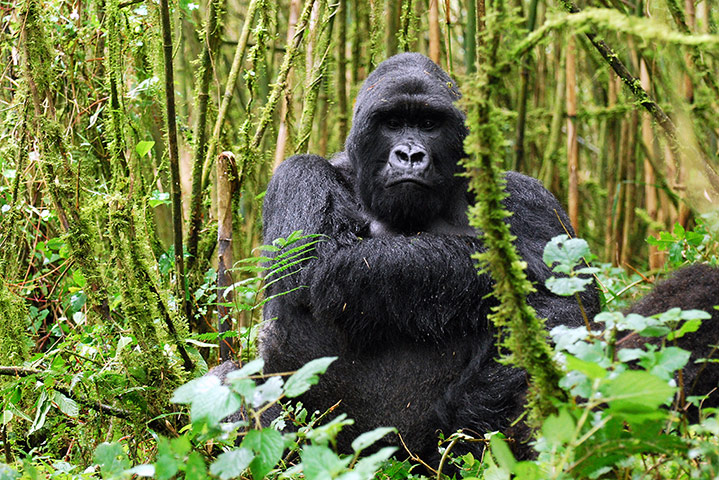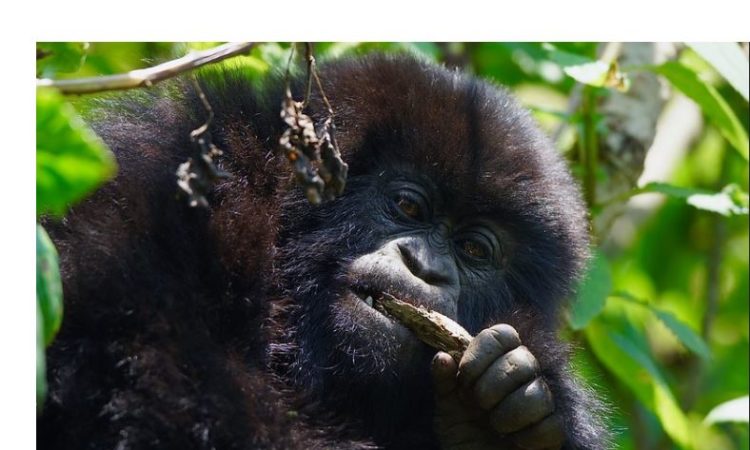A Complete Guide For Gorilla Trekking In Rwanda In 2024-2025 : Rwanda Gorilla trekking Safari experience: Trekking in Equatorial Africa to witness the mountain gorillas is an unforgettable experience that gives you a close-up look at the largest living primate on the planet. The majority of the estimated 1,000 remaining in the wild are thought to be dispersed around the Virunga Mountains, which cut through Rwanda, Uganda, and the Democratic Republic of the Congo. The population is gradually growing as a result of the work of NGOs, local communities, and government agencies, and gorilla trekking is essential to guaranteeing their preservation.
With Volcanoes National Park home to 12 gorilla families—Susa, Igisha, Karisimbi, Sabyinyo, Amahoro, Agashya, Kwitonda, Umubano, Hirwa, Bwenge, Ugyenda, and Muhoza—Rwanda provides the most accessible gorilla trekking experience among the three countries. Each group comprises a minimum of one silverback gorilla, in addition to multiple females and juveniles. Some are protected for scientific study, while others are open to tourists. In actuality, American primatologist and conservationist Dian Fossey carried out her studies in Rwanda from 1966 to 1985. Everything you need to know about gorilla trekking in Rwanda will be covered in this guide, including the cost, what to expect on the trek, and a suggested packing list.
HOW MUCH IS GORILLA TREKKING IN RWANDA?
As of this writing, obtaining a gorilla trekking permit in Rwanda costs USD 1,500, more than twice as much as those in Uganda ($700). The best way to get your permission is to work with a trustworthy tour operator, like Explore Rwanda Tours , who can help you with dates, lodging, and transportation. As an alternative, you can get availability information from the Rwanda Development Board, which oversees the nation’s national parks.
Since there are only 96 permits granted for gorilla trekking in Rwanda each day, making reservations in advance is strongly advised. You can expect an intimate experience that is both discreet for the gorillas and guarantees a limited number of permits—each gorilla tribe has only eight licenses. Although the amount of time spent trekking can vary greatly, each group is only allowed to spend an hour or less with the gorillas.
You may be wondering if gorilla trekking in Rwanda is worth the high expense of the permit alone. Anyone who has been to Volcanoes National Park will undoubtedly say “yes” when asked. Rwanda has more habituated mountain gorillas than Uganda or the Democratic Republic of the Congo. Additionally, because they are frequently found in areas of bamboo rather than deep forests, they are generally easy to locate.
Furthermore, it is feasible to take a plane to Kigali and then go on a daylong trek to observe the gorillas, an experience that is not feasible in Uganda or the DRC. Volcanoes National Park is only 116 kilometers from Kigali International Airport; it takes about 2.5 hours to get there by car. On the other hand, it takes more than eight hours to travel the 500 kilometers to the Bwindi Impenetrable Forest in Uganda from Entebbe International Airport, which is close to Kampala. The price differences between gorilla trekking in Uganda and Rwanda begin to equalize when transportation and lodging are taken into account.
Remember that 10% of the money received from the permits is reinvested in the neighborhood to support the construction of roads, schools, and health facilities. In order to ensure that the gorilla and human populations in the area can coexist peacefully, there is also a fund set up to compensate local farmers in the event that the gorillas destroy their crops. In addition to providing jobs for local trackers, guides, and porters, gorilla trekking is a major contributor to the local economy.
HOW HARD IS GORILLA TREKKING IN RWANDA?
Trekking to visit Rwanda’s mountain gorillas requires some fitness, but it’s not that demanding. Even in the dry season, the steep, muddy, and slippery forest trails might be difficult for certain individuals due to the mix of humidity and altitude.
The gorillas are wild animals, so there’s no guarantee they’ll be near the Kinigi Park Headquarters, where treks start. Depending on where they are exactly on any given day, you could walk for two to nine hours.
What, then, is the course of a normal gorilla trekking day? Everyone gathers at 7:00 am for a park ranger briefing, after which they are divided into groups according to fitness levels. You will depart around 8:30 a.m. accompanied by a trained tracker and guide, as well as a number of scouts and porters who can assist with carrying backpacks and other tasks. You will spend an hour with the gorillas after you come across them, and you must return to the park headquarters by 7:00 p.m.
IS IT SAFE TO SEE GORILLAS IN RWANDA?
With low levels of crime and strict security, especially in the vicinity of popular tourist destinations like Virunga National Park, Rwanda is among the safest countries in Africa. Poachers have been discouraged by the strong military and police presence, so there shouldn’t be any problems for you to deal with before, during, or after your journey.
If the gorillas are your concern, you may be confident that the scouts will defend you in the unlikely event that a silverback charges, since they are equipped for your protection. Additionally, they are skilled in guiding hikers to safety in the event that they come across dangerous creatures, and they know when to use their firearms to scare off the animals rather than kill them.
IS UGANDA OR RWANDA BETTER FOR GORILLA TREKKING?
The easiest to get to is Rwanda’s Volcanoes National Park, which is about a two- to three-hour drive from Kigali International Airport. The main entry point into Uganda, Entebbe International Airport, is at least eight hours’ drive away from Bwindi Impenetrable Forest. The typical route to reach Congo’s Virunga National Park is to fly into Kigali and then drive the four to five hours across the border. Alternatively, the closest airport to the park headquarters on the DRC side is Goma International Airport.
Because of the safety risks involved in visiting the DRC, most tourists choose between gorilla trekking in Rwanda and Uganda. Even though gorilla permits in Rwanda are USD 1500, compared to USD 700 in Uganda, you still need to account for the expense of lodging and transportation while visiting Uganda’s Bwindi Impenetrable Forest.
Although Volcanoes National Park has more difficult terrain than Bwindi, it is considerably easier to shoot the gorillas because they are frequently found in bamboo forests. Uganda permits younger children to go on gorilla treks, while Rwanda has a stringent 15-year-old age limit.

WHEN IS THE BEST TIME TO GO GORILLA TREKKING IN RWANDA?
Since it falls during Rwanda’s protracted dry season, June to September is usually regarded as the ideal time to undertake gorilla trekking. This is a rather simple time of year to enter Volcanoes National Park, and the trekking routes are less muddy and hazardous than they are during the rainy season. Due to high demand, you must secure your permit well in advance if you intend to go gorilla trekking at the busiest time of year.
Another excellent time to trek in Rwanda is during the country’s brief dry season, which lasts from December to February. Trekking during this season is not as popular as it is during the long, dry season, but permits still need to be obtained in advance.
Rwanda has a lengthy rainy season from April to May, during which time significant downpours are typical. The gorilla families tend to retreat to the lower slopes, so you might not have to go as far to see them, even though the trails are considerably more slippery than during the dry season.
October and November see the brief afternoon or evening downpours throughout the short rainy season. You should expect bright skies by morning. If you’re an avid birdwatcher, this is one of the best times to go because a large portion of the park’s vegetation is in bloom.
HOW MANY DAYS DO YOU NEED FOR GORILLA TREKKING IN RWANDA?
It is theoretically feasible to arrive in Rwanda by plane, go gorilla trekking, and depart the same day. However, in order to take advantage of everything the nation has to offer, including Akagera National Park and Nyungwe Forest National Park, we strongly advise staying for at least a few days.
A gorilla walk in Rwanda can be easily added at the beginning or end of your trip if you are going on safari in Tanzania or Kenya; it will only take one extra day to complete your schedule. Because of this, many people prefer Rwanda over Uganda and the Democratic Republic of the Congo as a destination for gorilla trekking.
WHAT DO I NEED FOR GORILLA TREKKING IN RWANDA?
It’s crucial that you prepare properly for your Rwandan gorilla hike to guarantee that you are protected from the weather (and the mosquitoes). This means wearing long sleeves and pants (khakis work best), as these will shield you from branches and plants that could scratch you.
Additionally, you should wear well-made, waterproof hiking boots with a solid grip that rise to just above the ankle. When you get there, you’ll see that the scouts and rangers have their pants tucked into their socks and gumboots on to keep out fire ants.
Additionally, a lightweight rain jacket is necessary, especially if you want to travel during the wet season. When choosing something to store in your backpack when not in use, go for something that is simple to fold up. Remember to apply sunscreen before you go and bring a wide-brimmed hat to shield your face and neck from the sun. Additionally, it’s a good idea to carry mosquito repellent for any exposed body parts.
For the chilly early mornings and evenings, a heavy sweater is a “must,” even though you might not need it while trekking. Be prepared because the temperature can dip to as low as 10°C or 50 °F. A camera must be included in your luggage if you intend to record your trip. A serious photographer would typically pack at least one zoom lens so they could get close-up pictures of the gorillas without endangering their safety.
HOW MUCH IS GOLDEN MONKEY TREKKING IN RWANDA?
Two habituated populations of golden monkeys reside at the base of Mount Sabyinyo in Volcanoes National Park. Currently priced at USD 100, permits to view the golden monkeys can be reserved in advance through tour operators or on the morning of the trip at the park headquarters. Trekking groups gather at the Kinigi Park Headquarters at 7:00 a.m.; there is currently no cap on the number of participants.
WHAT IS THE AGE LIMIT FOR GORILLA TREKKING IN RWANDA?
In Rwanda, children who wish to go gorilla trekking must be at least 15 years old. The age restriction is in place because of the high, mountainous terrain, and it is severely enforced. Explore Rwanda Tours can assist you in organizing an amazing journey to witness Rwanda’s mountain gorillas and take in everything that this amazing nation has to offer. Take a traditional safari through Akagera National Park, visit Nyungwe National Park to get up close and personal with chimpanzees, or travel the Congo Nile Trail to experience the breathtaking splendor of Lake Kivu.


